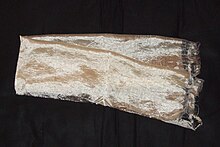|
Khata
 A khata /ˈkætə/ or khatag[1][a] is a traditional ceremonial scarf in Tibetan Buddhism and in Tengriism.[5][better source needed] It is widely used by the Tibetan, Nepalese, Bhutanese, Ladakhi, Mongolian, Buryat, and Tuvan peoples on various occasions. It originated in Tibetan culture and is common in cultures and countries where Tibetan Buddhism is practiced or has strong influence.[citation needed] The practice of using khatas has influenced people of other communities too who are in close relation to these communities. It is predominantly used in Tibet, followed by other parts of the world. It is a symbol of honour and respect. It is used in Tibetan religious ceremony and in traditional dances, and is offered in monasteries and in temples. In Nepal, a khata is used as a gift for various occasions like wedding, graduation, electoral victory, winning an award and several other major lifestones. Generally, the guests or invitees at the reception would put khata on the host of such parties. It is used by both Hindus and Buddhists of Nepal in that manner. HistoryTibetan people used to give animal skins as gifts because there was no silk in Tibet. According to the Bon historical record, people would put sheep wool around their necks during the time of the ninth king, Degong Jayshi, and head for some religious rituals. This tradition was passed down from that moment onwards. People began making scarves and using silk over time. So, the scarf replaced the plain sheep's wool and people put scarves on the neck and head. Uses and typesThe khata symbolizes purity and compassion and is worn or presented with incense at many ceremonial occasions, including births, weddings, funerals, graduations and the arrival or departure of guests. When given as a farewell gesture it symbolizes a safe journey. When given to arriving guests it symbolizes welcome. They were usually made of silk but now much more commonly cotton or polyester. Tibetan khatas are usually white, symbolising the pure heart of the giver,[6] though it is quite common to find yellow-gold khata as well. Tibetan, Nepali, and Bhutanese khatas feature the ashtamangala. There are also special multi-colored khatas. Mongolian khatas are usually blue, symbolizing the blue sky. In Mongolia, khatas are also often tied to ovoos, suvargas, or special trees and rocks.  Explanatory notesReferences
External links
|
||||||||||||||||||||||||||||||||||||||||||||||||||||||||||||||||

